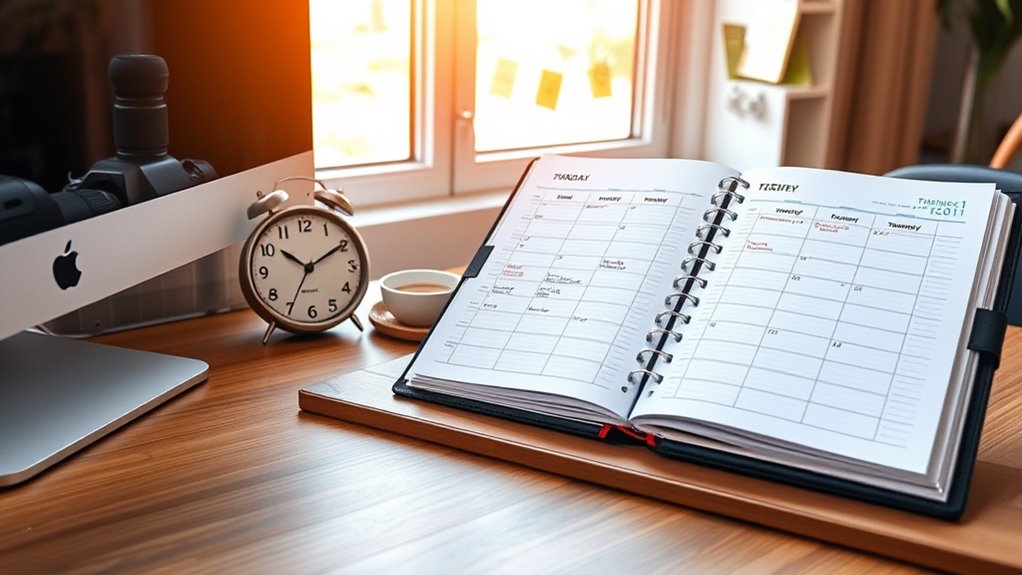To plan your day with intention, start by listing all tasks and prioritizing them based on urgency and importance. Use digital tools like calendar apps to block specific times for focused work, including breaks. Be realistic with your schedule, giving enough time for each activity and adjusting as needed. Incorporate buffer periods to prevent burnout and stay flexible. Keep practicing these steps, and you’ll discover more strategies to make your days more productive and purposeful.
Key Takeaways
- Prioritize tasks by importance and deadlines to focus on what truly matters each day.
- Use digital calendar tools to visually schedule and allocate specific time blocks for different activities.
- Assign realistic durations to tasks and include buffer periods to prevent overwhelm and maintain flexibility.
- Incorporate regular breaks and review your schedule regularly to stay balanced and adjust as needed.
- Consistently practice time-blocking to build a routine that enhances productivity and goal achievement.

Have you ever felt overwhelmed by your to-do list and unsure where to start? If so, you’re not alone. Many people struggle with managing their daily tasks, but one effective way to regain control is through time-blocking. To make this method work, you first need solid prioritization strategies. These strategies help you identify which tasks are most urgent and which can wait, ensuring you focus your energy on what truly matters. Start by listing all your tasks and then categorize them based on importance and deadlines. This approach prevents you from wasting time on less critical activities and keeps your day aligned with your goals.
Feeling overwhelmed? Prioritize tasks to focus on what truly matters and stay organized.
Once you’ve sorted your tasks, leverage digital tools to streamline your time-blocking process. Calendar apps like Google Calendar or Outlook allow you to visually allocate specific blocks of time to each task. These tools often come with features like reminders and color-coding, which make it easier to stay organized and on track. For example, you might designate morning hours for deep work—like writing reports or tackling complex projects—and afternoon slots for meetings or administrative tasks. Digital tools also allow you to adjust your schedule easily if priorities shift, giving you flexibility without losing sight of your plan.
When planning your day, aim to assign realistic time frames for each task. Overestimating or underestimating can lead to frustration or unproductive gaps. Use your digital tools to set alarms or notifications that remind you when it’s time to move on to the next activity. This way, you stay disciplined and prevent tasks from spilling over into your next time block. Remember, the goal of time-blocking isn’t to be rigid but to create a structure that promotes focus and productivity.
Another key to successful time-blocking is to include buffer periods between tasks. These short breaks help you reset and prepare for the next activity, especially if one task takes longer than anticipated. Digital tools often have features to help you see your day at a glance, making it easier to spot potential overlaps or overcommitments. Additionally, understanding how to effectively manage your schedule can be supported by familiarizing yourself with good time management principles, which include prioritization and realistic planning. Consistently reviewing and adjusting your schedule based on actual productivity and changing priorities ensures your time-blocking remains effective.
In the end, combining prioritization strategies with digital tools transforms a chaotic to-do list into a clear, manageable plan. It’s about working smarter, not harder, and dedicating your time intentionally to what truly counts. With practice, you’ll find that time-blocking becomes a natural part of your routine, helping you stay focused and achieve your goals each day.
Frequently Asked Questions
How Do I Handle Unexpected Interruptions During Time-Blocked Periods?
When unexpected interruptions occur during your time-blocked periods, handle emergencies calmly and swiftly. Manage flexibility by having a backup plan or adjusting your schedule as needed. Prioritize urgent tasks without guilt and reschedule less critical activities. Stay focused, communicate your boundaries if necessary, and remember that flexibility helps you adapt without losing productivity. This way, you maintain control while effectively handling emergencies.
What Tools Are Best for Digital Time-Blocking?
Digital calendars and time tracking apps are the best tools for digital time-blocking. They help you organize, optimize, and oversee your schedule seamlessly. Apps like Google Calendar, Outlook, and Todoist offer intuitive interfaces, customizable reminders, and easy integrations, making planning precise and portable. You’ll stay synchronized, streamline your schedule, and stay on track. These tools transform your time management, turning chaotic days into controlled, confident accomplishments.
How Can I Adjust My Schedule for Sudden Priorities?
When sudden priorities arise, practice flexibility planning by quickly reassessing your existing schedule. Identify tasks that can be postponed or delegated, then adjust your blocks accordingly. Reshuffle your priorities to focus on what’s urgent, while maintaining your overall goals. This proactive approach helps you stay adaptable, ensuring you’re responsive to unexpected needs without losing sight of your main objectives. Remember, regular priority reassessment keeps your schedule aligned with your changing demands.
Is Time-Blocking Suitable for All Work Styles?
Did you know 70% of workers believe productivity myths that hinder effective planning? Time-blocking isn’t suitable for all work styles, especially in diverse work environments. If you’re flexible and prefer spontaneous tasks, rigid time blocks might feel restrictive. However, if you thrive with structure, this method boosts focus. Adapt time-blocking to fit your style, ensuring it enhances your productivity rather than constrains it.
How Do I Evaluate the Effectiveness of My Time Blocks?
You can evaluate your time blocks’ effectiveness by tracking your productivity metrics and conducting a time audit. Review how well you complete tasks within each block and note any patterns of distraction or inefficiency. If you find that certain blocks aren’t productive, adjust your schedule accordingly. Regularly analyzing your progress helps you optimize your time blocks for better focus, efficiency, and overall productivity.
Conclusion
By mastering time-blocking, you’re planting seeds of intention in your day. Each block is a carefully tended garden bed, nurturing productivity and focus. As you tend this garden, your efforts bloom into achievements and clarity. Remember, your schedule isn’t just a plan—it’s a compass guiding you through your priorities. With each well-placed block, you’re shaping a life of purpose, where your time becomes the fertile ground for growth and fulfillment.









